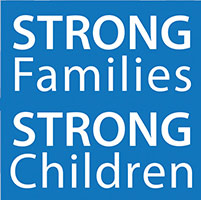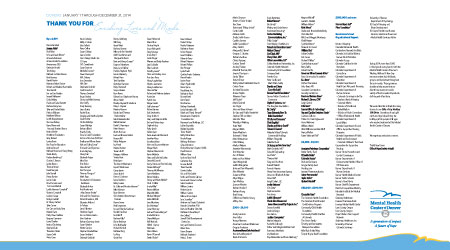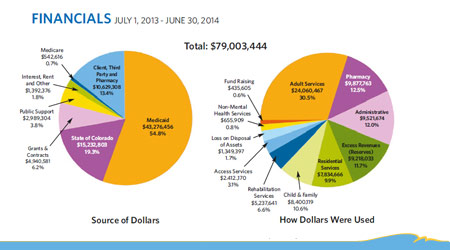2014 Report to the Community
Letter from Carl Clark, MD, President & CEO
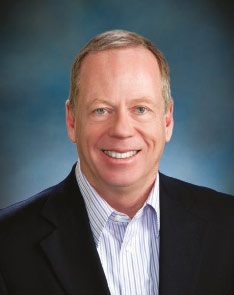 Then and Now: From Managing Illness to Promoting Well-Being
Then and Now: From Managing Illness to Promoting Well-Being
When the Mental Health Corporation of Denver opened on July 1, 1989, I was a staff psychiatrist. As the organization grew and changed over the following decade, our name changed from “Corporation” to “Center,” reflecting more accurately our role as a community-focused institution. My role also changed several times, and by 2000, I was asked to serve as the acting CEO, and later to take the job permanently.
In our first quarter century, we have seen enormous change in our world, our community, and in the science of mental health. Change is also constant within the organization, partly to adapt to the changing environment, and more importantly, to get in front of change and lead it.
When we opened a generation ago, our focus was on illness. Today, we focus on recovery and resilience. We now understand that mental illness isn’t a defining life condition, but a challenge that can be overcome with treatment and support. How do we know this? Because we—the WellPower—have figured out how to measure recovery.
Why is this important?
If you have surgery, your doctor can tell you how long before you can resume normal activity. If you break your leg, your doctor can tell you how long it will take for your bones to mend. People with mental illness have the same questions. How long will this last? What will happen to me? When can I have the life I want?
To begin answering these questions, we first needed to find out what our consumers wanted. And they told us: a place to live, a job, good relationships, a sense of connection to their community. These were starting points for objective measurement standards. We began changing treatments and measuring outcomes to see what worked and what did not. The most important thing we learned is that the hope of recovery itself was a key factor in recovery.
We also learned that when consumers see their progress, it leads to hope, and hope leads to setting goals, and people with clear goals get better faster.
This approach led us to see our organization in a new way. We asked the question, “How do we move from the land of illness management to the land of recovery?” We discovered our goal: to be the national center of excellence for recovery and resiliency in mental health. As we design programs, our guiding strategic question is this: “Would the national center for excellence in mental health do this?” If the answer is yes, we find the resources and we do it.
How do we measure our progress? For one thing, we are nationally recognized for our recovery model. For another, we can serve more people because our recovery approach shortens the time consumers spend in intensive treatment. Hope, it turns out, is our most effective therapeutic tool.
Our new frontier in mental health is to move beyond recovery to well-being—a concept that comes from the school of positive psychology. The foundation of well-being is to experience positive emotions every day: joy, gratitude, inspiration, hope, love and more. Positive emotions sustain our well-being and our motivation to keep moving forward toward the life we want.
I’m grateful for a quarter century of working, learning and collaborating with so many dedicated people who continually strive to make mental well-being accessible to all.
Carl Clark, MD, President & Chief Executive Officer
2014 By the Numbers
Awards & Accolades
This year we celebrated our 25th year in the community. Below is a comparison of our organization from 1989 to 2014.
- Recipient of The Denver Post's Top Workplaces recognition for the second straight year
- Finalist in ColoradoBiz Magazine's Top Company Competition
- The Recovery Center, opened in 2012, named one of the Top 10 LEED Projects for 2014 by Interiors and Resources Magazine
Breaking New Ground
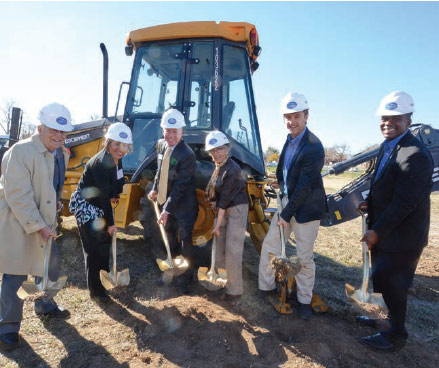
On October 30, a host of dignitaries, neighbors and supporters came together on a sunny morning for the formal groundbreaking of the new Dahlia Campus for Health and Well-Being. Slated to open in Fall 2015, the vision for Dahlia Campus is to offer children, families and community members a welcoming place to improve their overall well-being through health promotion, prevention and early intervention programs.
Fundraising Success
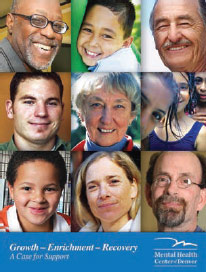
The WellPower’s first-ever fundraising campaign reached the finish line—and then some. The Growth-Enrichment-Recovery campaign ended on June 30 after raising $8.5 million, a half-million dollars above its goal. The funds support the remodeling of the Recovery Center, expansion of services in all areas and community outreach efforts.
Strong Families | Strong Children
The WellPower has launched a capital campaign to raise an initial $5 million to support the design, construction and operation of Dahlia Campus for Health and Well-Being. Proceeds from the November 5 Gifts of Hope breakfast helped launch the campaign, including a $1 million gift. Click here to support the campaign.
Putting Clients to Work for Recovery
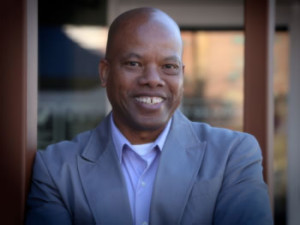
In 1991, Gary Fair’s first job at the WellPower was transporting consumers who lived in the organization’s residential facilities to day treatment programs. Over time he steadily built his career in the NextChapter Program. Today he is a program manager overseeing three teams comprised of consumers who work for the WellPower part-time—greeters at the Recovery Center, the Pro-Survey team, and the 17-member peer mentor team.
When I first started 23 years ago, I didn’t intend to stay. But I kept getting the chance to do different kinds of jobs over the years. The one that stands out is employment specialist. I gained a lot of insight and experience in working with people where they are at.
I helped several people get jobs who are still employed, and I still have a relationship with some of them and support them even now… coaching them to go for a position they’ve dreamed about.
It’s great they’ve been able to keep a job with a livable wage, and even for some to get off public assistance and keep moving along in their recovery.
One of my best stories is about a man who had a really difficult time getting out in the community. We would meet in coffee shops, and I eventually got him to come into NextChapter and work on his resume and set job goals. He had a talent for website development, so we helped him with a job he could do on his own. Now he’s had his own business working out of his home for about six years. That’s after having very little hope and being unsure of himself.
I’ve also seen a lot of disappointments and setbacks, but more success stories. That is what makes it worth it.
As for the future, peer support is really the going thing right now. Peer support will be used more and more to help consumers toward recovery. There’s no substitute for really understanding and saying, “I know what you’re going through,”—to be a good model for someone going through a severe state of depression and showing them that you got through and are still here today.
I can’t see myself doing anything else—watching people grow… working for an organization that believes people can and do get better… and witnessing that firsthand.
Setting Higher Standards for Care
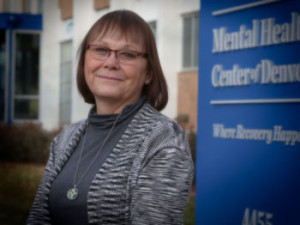
Colorado native Kristi Mock began her career as a student intern at Bethesda Mental Health Center. She later joined Park East Mental Health Center as a social work therapist. In 1989 Bethesda, Park East and two other Denver mental health centers consolidated into the WellPower. Today, as Vice President of Adult Recovery Services, she oversees the organization’s residential facilities, adult services and the Access Center. She played a significant role in planning and developing the Recovery Center, which opened in 2012. Most recently, she organized the startup of Denver’s new Walk-In Crisis Center, part of a recently created statewide network of services that provide immediate help to people in need.
In college, I thought I would get a Ph.D. and become a school psychologist. In my senior year, I did an internship at a community mental health center and state hospital on Maryland’s eastern shore and I absolutely loved what I did. I finished my psychology degree and decided to get a master’s degree in social work. When I started working in the 1980s, community mental health centers were fairly well established. The four serving Denver were quite distinct, and lacked collective power. They had catchment areas, meaning that they served consumers based on geographic boundaries. When consumers moved, as many did, their care would transfer to a different center, making it more difficult to receive excellent and continuous treatment.
All four centers replicated services, so they weren’t robust in meeting diverse needs, and they had limited availability. The four centers replicated services with limited availability and were not meeting diverse needs.
Becoming one mental health center, serving all of Denver, was really challenging and a really good thing to do. Instead of four separate sets of programs, we were able to have one strong program. I firmly believe that the changes we made along the way have taken us in a better direction.
I am very proud of the changes and improvements that came about in the availability and quality of services in the 1990s. At the time, some people believed that our new, intensive services were of the “Cadillac” variety. In fact, though, we created a new standard of treatment that was appropriate to meet the needs of the people we served. Today we no longer believe our job is just about keeping people out of the hospital, it’s about helping people recover from mental illness and homelessness, and to experience a sense of well-being. This new standard is helping people live the rich and meaningful lives they want—being part of the community where they live, having connections to friends and family members, access to jobs and education, safe and affordable places to live.
I’ve been richly rewarded by being part of the work we’ve done over the years… to support and foster healthy, happy lives and to see the life changes that occur in the people we serve. It is inspiring to see people not just surviving, but flourishing.
25 Years | 25 Stories, Lola Duran
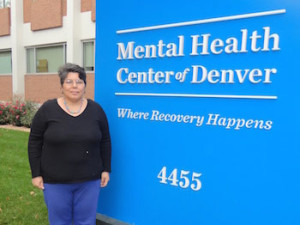
I moved to Denver from Colorado Springs several years ago. While in Colorado Springs, I received treatment from the AspenPointe community mental health center. In 2012, I was the AspenPointe ACCESS Center’s Consumer of the Year.
In Denver, I was not in regular outpatient treatment and found myself going in and out of psychiatric units. With the help of a social worker, I did an intake at the WellPower and now I’m a client – not just a number but a person.
People should know that I realize now that I do have a mental illness, but I am not the illness; I will always have my ups and my downs. I have grown a great deal with new coping skills behind me and with effective communication I will continue growing!
Among the coping tools I use to support my healing is PLEASE Master:
PL Treat Physical iLlness
E Eat healthy
A Avoid mood altering substances
S Sleep well
E Exercise
Master some activity, such as making yarn flowers and yarn dolls.
I am very proud of my daughters and of finishing Dialectical Behavior Therapy class. For the next step on my journey, I will be taking the Trauma Recovery and Empowerment Model class.
I don’t know what my future is going to hold, however I do know one thing: with each step I am going to love myself more and learn as much as I can.
I look forward to having a positive attitude toward everyone I come in contact with but most of all have a better relationship with my daughters and family.
Blazing New Trails in Young Adult Programs
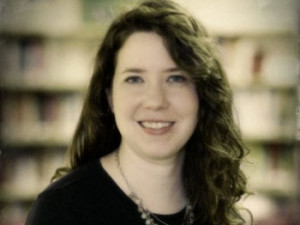
A graduate of Boston University with a major in philosophy and a minor in political science, Becky Armstrong’s career interest shifted to mental health even before she got her degree. She was struck by the lack of resources and the stigma of mental illness after several friends and family members experienced mental health crises. Her first job out of college was with the national office of Active Minds, an advocacy organization that raises awareness about mental health on hundreds of college campuses. She began her next job at the WellPower in 2013 as a vocational counselor with NextChapter.
Before I moved to Denver, a mentor of mine told me the only place to work was the WellPower. For her and many others in the field, this organization represents a true recovery-based model that instills hope in the lives of an underserved and misunderstood population.
I was given the opportunity to utilize my passion for young adults in The Downstairs, an effort launched in February 2013 to better serve the needs of 16- to 24-year-olds in Denver with a mental health condition. In our field, we refer to this age group as Transition Age Youth because of the many pivotal life decisions they have to make at that time of life, from first jobs, to college applications—often without much guidance.
Many young adults also experience their first episode of mental illness during these years and have few services available for them. Preventive care at that time is key. The Downstairs is our way of filling this gap in service and putting young adults on the path to lifelong success.
While Transition Age Youth programming is still in its infancy, The Downstairs has the opportunity to break new ground and establish best practices for mental health centers nationwide. A key best practice is meeting our young adults where they are. Millennials communicate in specific ways so we have to find different ways to reach them. They want to learn from a website, not from a packet of paper to read. They text, they don’t call. They use abbreviations. To find out about depression, they go to YouTube.
The program is hosted one night a week in a nontraditional, coffee-shop-like environment that is familiar to them and allows them to feel relaxed and secure. We have a meal and talk about how everyone is doing. We talk about things like interview skills and current events and about workshops they would like to have. It’s a chance for these young people to socialize with others going through some of the same things. We create an environment where no one is judged, everyone is given a voice and there is support everywhere you turn.
As a counselor in this program, and a staff member of the WellPower, I am proud of the innovative and thoughtful growth of this organization. With programs like The Downstairs, we are reaching new populations in profound ways, and continuing our reputation of excellent care.
Designing Something New by Integrating Cultural Competence
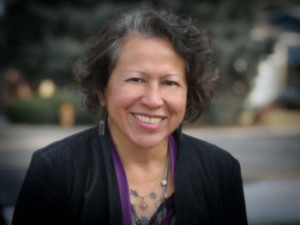
Hailing from Los Angeles’ East Side, Lydia Prado grew up feeling culturally enriched, speaking both English and Spanish, and thriving in a community where she was surrounded by many talented, creative and resilient people. When she left to attend college, she was surprised to learn that the mainstream and academic view of her community was filtered through a lens of deficits rather than strengths. She earned her doctorate at the University of Denver and later served on its faculty. Today, as Vice President of Child and Family Services at the WellPower, Dr. Prado weaves together evidence-based best practices with respect and understanding of diverse cultural strengths to develop more effective, holistic approaches to services. She is directing the development of the new Dahlia Campus for Health and Well-Being which will embody this integrated strategy. It will open in 2015.
When I finished my undergraduate degree, I chose to attend graduate school in clinical psychology rather than going to medical school. I was drawn to research because my life experiences did not jive with what I was learning in the classroom. A research doctorate would get me closer to reconciling these seemingly opposing worldviews.
I focused my graduate work on strength-based interventions with particular attention to embedding cross-cultural lenses. I valued cultural competence, believing you have to make any strategy in prevention and intervention meaningful to the folks you are serving.
For example, there are abundant ways to raise healthy children, so we have had to learn how to modify and revise best practices to work with different populations with different strengths and ways of being. In my academic experience, I saw programs typically developed based on the cultural majority—a well-resourced nuclear family model with an emphasis on autonomy, independence and individualization. This is but one version of mental health.
As we build the new Dahlia Campus for Health and Well-Being, we have the opportunity to truly collaborate across cultures. We are taking the best of academia, cultural competence expertise, community-based participatory research practices and community experience and input to design something new. We are leveraging multiple partners to build a campus that will resonate with the community, staff, our whole organization and the mental health field overall.
We have to get beyond fracturing care. This is our opportunity to be less narrow and more integrative in our approach. We have broken ground following two years of conversations with, and lots of listening to, natural leaders in the community, neighbors, and resident groups invested in the community. There are many strengths to build on and amazing things are happening.
The Dahlia Campus will have many doors to walk through, even a garden and greenhouse. We want to support families and individuals comprehensively, so we have to think about the food people are eating, the means by which they arrive, the precautions taken for their safety, and the most appropriate level of care. It’s about overall well-being. What we hope to see are healthier children, healthier families, healthier neighbors, and a thriving community. We don’t know of anything else quite like it.


